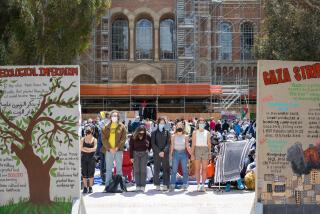Op-Ed: The Harlem Hellfighters show that diversity is America’s advantage in both war and peace

- Share via
A century ago, on Feb. 17, 1919, the U.S. Army’s 369th Infantry Regiment, nearly 3,000 African American soldiers and known as the Harlem Hellfighters, returned from World War I and marched up Fifth Avenue in Manhattan before hundreds of thousands of cheering New Yorkers. The Harlem Hellfighters weren’t supposed to be heroes, but they were among the “hyphenated” troops whose accomplishments demonstrate that the United States’ asymmetric advantage, in war as well as in peace, is diversity.
The 369th Infantry Regiment was part of the Army’s Rainbow Division, 27,000 troops from across the country quickly mustered after the U.S. entered World War I in April 1917. Most of the division shipped out to Europe in August of that year; the Hellfighters didn’t arrive in France until late December. They had not been allowed to march off to war with the rest of their Rainbow Division because “black is not a color of the rainbow.”
American military leaders expected the troops of the 369th to be terrible soldiers. Like most black recruits in World War I, they weren’t intended to fight but to be manual laborers at the front. They were issued inferior uniforms and weapons, and then, in an emergency, they were transferred to the French army, whose officers were explicitly told to treat them as second-class soldiers.
Despite the discrimination and the disadvantages, the men of the 369th became one of the war’s most decorated and celebrated units. They fought for 191 days, longer than any other U.S. unit. In that time, they never lost a trench to the enemy or a man to capture. They earned the respect of both allies and enemies. The Germans they defeated were responsible for their signature nickname.
Despite the discrimination and the disadvantages, the men of the 369th became one of the war’s most decorated and celebrated units.
At 11 a.m. on Feb. 17, three months after the armistice, the Hellfighters began their 7-mile homecoming march — the first such parade for any American troops in New York. The New York World newspaper recorded that, despite weather that hovered in the 30s, “no more joyful, cheerful, enthusiastic reception was ever recorded anywhere” and noted that “white folks mingled with their colored brethren in the lower part of the avenue, but there the crowd was mostly white.” At 60th Street, the official reviewing party included New York Gov. Alfred E. Smith, senior military officers and city luminaries including New York Journal publisher William Randolph Hearst.
Leading the Hellfighters was the regiment’s commander, Col. William Hayward, a forward-thinking white officer, but according to the New York Times, it was the parade’s “big man,” Sgt. Henry “Black Death” Johnson, who pushed the crowd to “hysterics.”
Johnson had earned his fame on May 15, 1918, when his two-man outpost in France’s Argonne Forest was attacked by two dozen German raiders. With ammunition gone, and his partner, Pvt. Needham Roberts, wounded, Johnson fought off the attackers with little more than a bolo knife and prevented Roberts’ capture. “Black Death” was just 5-foot-4 and weighed 130 pounds.
When Johnson was asked about his heroic exploits, the former Albany, N.Y., train porter responded: “There wasn’t anything so fine about it. Just fought for my life. A rabbit would have done that.”
Enter the Fray: First takes on the news of the minute »
But bravery like that cannot be ignored. The commander of the American Expeditionary Force, Gen. John J. Pershing, explicitly mentioned Johnson’s heroism in a dispatch just a few days after the fight. The French army in the sector stood at attention while Johnson and Roberts were awarded the Croix de Guerre, France’s highest military honor, and Johnson’s medal included the Gold Palm for extraordinary valor. Former President Theodore Roosevelt would call Johnson one of the “five bravest Americans” of World War I, but it would take until 2015 for Johnson to receive the Medal of Honor, decades after his death.
Twenty-five percent of the Americans fighting in France were hyphenated Americans. Native Americans, like the Choctaw code talkers, wielded their language as an unbreakable military code during the war (and inspired the Navajo code talkers of World War II). Chinese American Sgt. Sing Lau Kee, from San Jose, held his post through gas and shrapnel attacks, earning a Distinguished Service Cross and praise from a fellow soldier who called him “the best American” in the unit. And Pvt. Marcelino Serna, a Mexican American who migrated to El Paso before the war, took out an enemy machine gun, a sniper, and an entire German platoon on his own, becoming the most decorated Texan of World War I.
The Hellfighters, Kee and Serna of 100 years ago remind us that what matters most isn’t race, ethnicity or national origin — they are century-old proof that while American society might not be color-blind, heroism is.
Max Brooks and Lt. Col. ML Cavanaugh are non-resident fellows with the Modern War Institute at West Point. Brooks wrote “The Harlem Hellfighters,” and they co-edited “Winning Westeros: How Game of Thrones Explains Modern Military Conflict.”
Follow the Opinion section on Twitter @latimesopinion and Facebook
More to Read
A cure for the common opinion
Get thought-provoking perspectives with our weekly newsletter.
You may occasionally receive promotional content from the Los Angeles Times.









